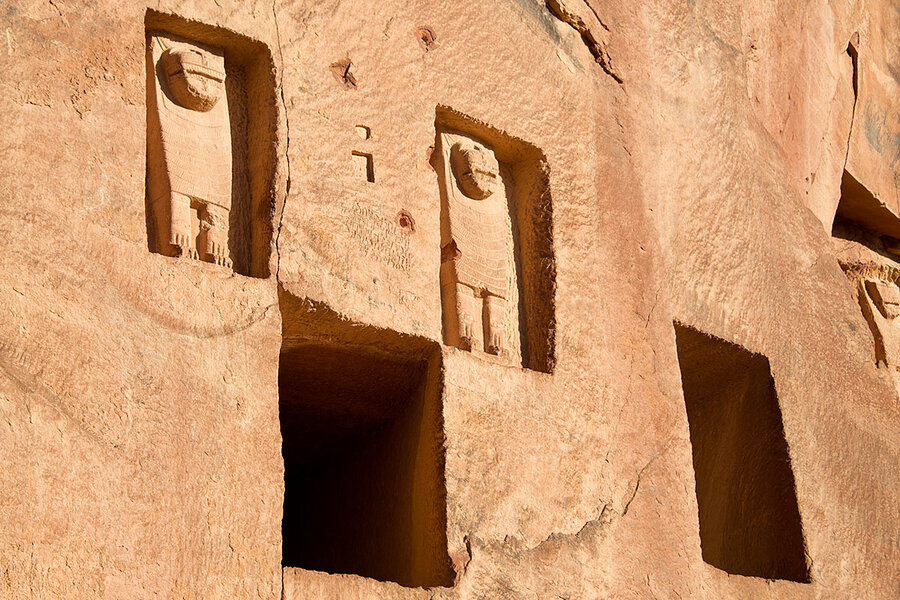Digging up forgotten kingdoms, Saudis unearth ancient identity
Loading...
| AL ULA, Saudi Arabia
Tarek never knew his daily commute was in the footsteps of ancient Arab kings.
The 30-year-old Al Ula resident runs his hands over the exposed brick and rock inscriptions he has known since a child as “the ruins,” listening as a tour guide lists the achievements of the tribes that built a kingdom on these sands 3,000 years ago.
Squinting at the rock-carved tombs in front of him, he sees something greater than a civilization: a connection.
Why We Wrote This
For centuries Saudis have been living above and amid evidence of a rich heritage. But only after an official shift in attitude toward pre-Islamic history has archeology allowed them to embrace their past.
“They prayed, they grew dates, they performed pilgrimages and welcomed visitors to the oasis like we do today,” Tarek says as he stops to pose for a selfie in front of a rock engraving.
“They lived just like us.”
Today Saudi authorities and archaeologists are unearthing and promoting Dadan and Lihyan, two Arab kingdoms whose traces have lain under sand and obscurity for centuries. Cited in the Old Testament and ancient Greek texts, the ancient kingdoms once ruled vital trade routes.
Saudi citizens are pointing to the kingdoms as proof not only that this arid region was home to civilizations centuries before the modern oil boom, but that the people of Saudi Arabia are the latest in a proud lineage stretching back millennia – that there is more to being a Saudi than oil and religion.
“Missing piece” of ancient map
Mesopotamia, Pharaonic Egypt, Phoenicia, Persia. These names of Middle Eastern civilizations have echoed through the centuries, capturing humanity’s imagination, recalling greatness, and inspiring art, literature, films, and entire fields of study.
Yet while most of the Middle East and Mediterranean were rich in legendary city-states, the vast Arabian deserts were, for generations of archeologists and academics, flyover country of little note or historical value. A blank spot on the map of the ancient world.
If they were so great, where are the monuments? Where are the cities?
The cities, it turns out, are still being unearthed. And what has already been uncovered of Dadan and Lihyan in the deserts of northwest Saudi Arabia has turned conventional wisdom on its head.
Here in Al Ula, the remnants of these sprawling desert kingdoms from the first millennium B.C. are woven into the landscape: Temple columns, 1-meter-thick brick walls, rock-carved tombs, detailed statues, and inscription-scrawled boulders poke out among date farms, houses, and newly-established eco-resorts.
Most of what scholars know today of these kingdoms is from the hundreds of rock inscriptions scrawled across the area in the Dadanite language, a Semitic offshoot, telling of kings and pilgrims, migrant communities, and daily life and death. And taxes.
On a Saturday in March, Thuraya, an Al Ula resident, guides visitors through Jabal Al Ikma, one of Al Ula’s craggy gorges scrawled with hundreds of pristine Dadanite, Lihyanite, and early Arabic inscriptions.
“This is their library, a collection of their civilization and stories carefully carved into stone,” says Thuraya, who was trained to interpret rock art.
“Lihyanites and the Dadanites,” she says “were advanced kingdoms that you could put in the same sentence as ancient Egypt or Mesopotamia.”
The Dadanites controlled the lucrative trade of incense – namely frankincense – which was cultivated in Yemen and carried on camel caravans through Dadan en route to temples in Pharaonic Egypt, Mesopotamia, and the Levant, where this fragrant tree resin played an important role in religious ceremonies.
Centuries before the Nabataeans rose up from Petra, in modern Jordan, as the dominant ancient Arab power, the Dadanites used the incense trade to transform this sleepy palm-dotted oasis into a regional economic powerhouse.
“Incense was the petrol of the times, this is why Dadan flourished,” says Abdulrahman Alsuhaibani, an associate professor at King Saud University in Riyadh who has been leading excavations at Dadan for the past decade.
What has been excavated speaks to their advancements: one temple features perfectly square tombs and intricate lion statues carved into the rockface. At another, wells and an 8-foot-tall stone basin believed to have been used for ablution by pilgrims coming to give tribute to a pantheon of gods suggest an advanced water management system.
In the fifth century B.C., another tribe built upon Dadan to create Lihyan, an empire extending west into the Gulf of Aqaba and Sinai and north toward the Levant.
What has been uncovered speaks to the Lihyanites’ influence: two imposing larger-than-life statues of Lihyan kings, standing like half-robed pharaohs, were recovered at a Lihyanite temple and have since been on tour in Paris.
More than 3,000 smaller statues were found inside the Temple of the Lions in six weeks of excavations alone. Local residents say they have seen “dozens” of statues and human-shaped stone idols over the years while picnicking in the valleys.
This is likely because Lihyan’s economic juggernaut was built not only on incense trade, but on tribute paid at its temples. It also was a hub for dried dates, which have grown in abundance here for nearly 3,000 years and travel well on weekslong desert treks.
Today, this same oasis accounts for one-third of Saudi Arabia’s date production and is renowned across the country. Stop by any shop or home, and an Al Ula resident will eagerly offer you a platter of the sugary-sweet halweh and burni dates that once powered this ancient kingdom.
Such was Lihyan’s fame, ancient Greek cartographers and Pliny the Elder referred to the Gulf of Aqaba as the Gulf of Lihyan, a name that was in use for three centuries.
But then, shortly before the first century B.C., the rival Nabataeans from southern Jordan inhabited Lihyan and transformed it into the town of Al Hajr, or Hegra, the second city of their empire. Within years, all mention of Lihyan suddenly stopped.
A few miles to the north, the Nabataeans built Madain Saleh, majestic tombs carved into rock mounds that rival Petra.
With such rich and diverse history, archaeologists are now calling Al Ula an “undiscovered country.”
But that’s only because for so long this site was overlooked by Orientalists chasing Biblical and Hellenistic lore and shunned by Saudi governments who saw the remains as the un-Islamic relics of pagans.
Only since 2017 has the Saudi leadership devoted a vast amount of resources for the archaeological investigation and preservation of Al Ula, in the process informing its citizens of these lost civilizations.
Newfound pride in history
Mohammed Abdullah, a 22-year-old university student from Jeddah, hoists up his phone as he walks between the hundreds of inscriptions and drawings carved into the gorge of Jabal Ikma, livestreaming his visit.
“We saw photos of a rock tomb in a history book, but we thought these were a cursed people that had nothing to do with us,” says Mr. Abdullah. “We never thought that these people were Arabs and could be our ancestors.”
“This is something to really be proud of.”
The Royal Commission for Al Ula, along with French, German, and British teams and colleagues from King Saud University, will expand excavations and are set to undertake specialized studies to learn more how these ancient peoples lived, cultivated, and traded here over the millennia.
Already excavations have unearthed almost as many questions as statues.
Are the Dadanites and Lihyanites the same people? What happened to the Lihyanites? Why are they not mentioned once in the hundreds of Nabataean inscriptions in Al Ula or elsewhere?
But for many, the most important question has been answered: What’s so special about ancient Saudi Arabia?
“We have civilizations on the Arabian Peninsula that are no less than the ancient civilizations in Mesopotamia, the Levant, and Egypt,” says Mr. Alsuhaibani, the archaeologist.
“We should be proud of our history, and we are on our way to let people know about it.”










